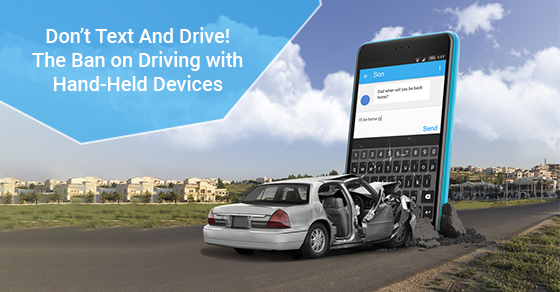Don’t Text And Drive! The Ban on Driving with Hand-Held Devices

The Highway Traffic Act is a provincial statute which classifies traffic offences and regulates the licensing of vehicles, among many other transport related issues. One of the most impactful additions for motorists in Ontario in the recent decade was the prohibition of using, or even holding a hand-held wireless communication device while driving.
Section 78.1(1) of the Highway Traffic Act legislates this prohibition:
No person shall drive a motor vehicle on a highway while holding or using a hand-held wireless communication device or other prescribed device that is capable of receiving or transmitting telephone communications, electronic data, mail or text messages.
The prohibition of using hand-held wireless communication devices while driving has been subject to cause for confusion for some Ontario motorists who do not fit neatly into the definition as set out in the Highway Traffic Act . For example, does briefly using one’s phone as a GPS (Global Positioning System) contravene this prohibition? Does merely holding a cellphone where an individual’s service provider can prove that the cell-phone in question was not texting or calling around the time of the offence constitute a contravention of this prohibition?
A growing body of case law (past rulings by judges that set precedents) has tried to interpret this prohibition. R. v. Kazemi confirmed that the purpose of the Highway Traffic Act is to protect those who use the roads of Ontario. This includes motorists and pedestrians alike. Section 78.1(1) was added to the Highway Traffic Act not to inconvenience motorists, but rather to facilitate and encourage the creation of safer roads for everyone who uses them. The presiding justice in Kazemi stated,
“For safety’s sake, drivers should focus on one thing and one thing only: driving. Road safety is best ensured by a complete prohibition on having a cell phone in one’s hand at all while driving.”
In Kazemi , the defendant was observed by a police officer to have a cellphone in her hand while stopped at a red light. The defendant claimed that her cellphone was lying on the seat and fell to the floor when she came to a stop, so she picked the cellphone up at the red light. The defendant claimed that this was when the police officer observed her with the cellphone in her hand. The trial court justice convicted the defendant pursuant to Section 78.1(1) of the Highway Traffic Act . The defendant admitted to holding the cellphone, and was therefore found to be holding the cellphone for the purposes of Section 78.1(1). On appeal, the Ontario Court of Justice further reasoned that, “there must be some sustained physical holding of the device in order to meet the ‘holding’ requirement, and that the momentary handling here was insufficient to establish that requirement.” However, the Ontario Court of Appeal reversed the Ontario Court of Justice’s decision, and reinstated the trial court’s charge against the defendant, reasoning that a sustained physical holding does not reflect the purposes of Section 78.1(1) of the Highway Traffic Act . Additionally, “sustained” was argued to be too arbitrary of a word to be used in its ordinary sense. Therefore, the court found that the mere holding of a cellphone constituted a contravention of Section 78.1(1) for the purposes of the Highway Traffic Act .
In R. v. Beaulieu , the defendant was stopped at a red light while her cellphone was in her hand. The police officer observed her touching the screen of her cellphone, and charged the defendant with an offence pursuant to Section 78.1(1) of the Highway Traffic Act . The defendant argued that she was using her cellphone as a GPS while it rested on her lap, and that she was listening to the cellphone as it gave her instructions. The defendant maintained that she was not looking at the screen of the cellphone. The trial judge in Beaulieu found the defendant guilty of the offence contrary to Section 78.1(1) of the Highway Traffic Act , citing:
“A GPS must be securely placed or fixed in the motor vehicle so as not to move while the vehicle is running and the driver can see it by taking a quick look and can access it easily without adjusting the driving position”
In R. v. Pizzurro , the defendant was driving while a police officer observed him holding and looking at his cellphone. The defendant was charged with an offence pursuant to Section 78.1(1) of the Highway Traffic Act . The defendant argued that his cellphone was not capable of receiving or transmitting text-messages or calls at the time of his stop. The Ontario Court of Appeal held that the trial court’s conviction should be upheld, maintaining that the Crown, or prosecutor does not have to prove that a cellphone was capable (or incapable) of receiving and transmitting signals. The Ontario Court of Appeal further reasoned that cellphones are universally known to be capable of receiving and transmitting signals, and to place the burden on the Crown to prove or disprove this would be unreasonable for enforcement purposes.
The fundamental purpose of Section 78.1(1) Highway Traffic Act is to protect those who use the roads of Ontario. Ontario motorists should keep their eyes on the road, and free of distractions. A wealth of case law supports this idea, in that cellphone, irrespective of how they are being used or for the duration thereof, constitutes a distraction for the purposes of the Highway Traffic Act .

